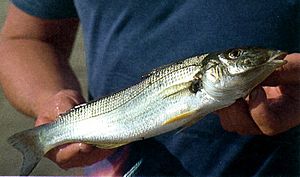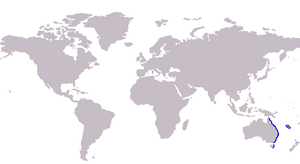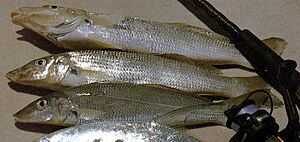Sand whiting facts for kids
Quick facts for kids Sand whiting |
|
|---|---|
 |
|
| A sand whiting fish swimming near Byron Bay, New South Wales | |
| Conservation status | |
| Scientific classification | |
 |
|
| Where the Sand whiting lives | |
| Synonyms | |
|
The sand whiting (Sillago ciliata) is a common type of fish that lives near the coast. It's part of the smelt-whiting family, called Sillaginidae. This fish is long and a bit flat, looking very much like other Sillago species. To tell them apart, scientists often count their spines, rays, and lateral line scales.
You can find the sand whiting along the east coast of Australia, from Cape York down to Tasmania. They also live around Lord Howe Island and New Caledonia in the Pacific Ocean. These fish usually live in shallow, sandy areas like bays, estuaries, and where waves break on beaches. They eat small worms, crustaceans, and bivalve molluscs.
Sand whiting have been important for food since they were first described in 1829. Both people who fish for fun and commercial fishermen often try to catch them in New South Wales and Queensland. Because they are so important for fishing, a lot of research has been done on them. Scientists have even looked into raising sand whiting on farms, a process called aquaculture.
Contents
About the Sand Whiting
The sand whiting is one of over 30 types of fish in the Sillago group. This group belongs to the smelt whiting family, Sillaginidae.
A French scientist named Georges Cuvier first identified and named this fish in 1829. He got a fish sample that was said to be from the "Southern seas," likely near Tasmania, Australia. Over time, other scientists gave it different names, but Cuvier's original name, Sillago ciliata, is the official one. Some confusion happened because the sand whiting looks very much like a close relative, Sillago analis.
The name 'sand whiting' comes from where they like to live: sandy areas. Other whiting fish might prefer muddy or grassy places. People also call them 'blue-nose whiting' because bigger fish can have a blue tint on their nose. Another common name is 'summer whiting.' This name is used because these fish move from deeper waters to shallow beaches and estuaries in the summer. This makes them easier for people to catch.
What Does a Sand Whiting Look Like?
The sand whiting looks a lot like other fish in the Sillago group. It has a long, slightly flat body that gets narrower towards its mouth. It has two dorsal fins on its back. The first one has thin spines, and the second has soft rays with one spine. Its belly is straight. These fish can grow up to 51 centimeters (about 20 inches) long and weigh around 1.25 kilograms (about 2.75 pounds).
Looking closely at their fins helps tell them apart. The first dorsal fin has 11 spines. The second dorsal fin has one spine and 16 to 18 soft rays. The anal fin on their belly has two spines and 15 to 17 soft rays behind them. They also have 60 to 69 lateral line scales and 3-4 rows of scales on their cheeks. They have 32 to 34 vertebrae (backbones).
The sand whiting's body is usually pale brown or silvery brown. Their belly is white. When they are first caught, they might have green, mauve, and rosy colors. Some fish have a faint silver-yellow stripe along their side. Their fins are usually pale yellow or olive green, with some darker spots or margins. Young sand whiting, less than 90 mm (about 3.5 inches) long, might have darker spots on their sides and backs.
Where Sand Whiting Live
Sand whiting live along the east coast of Australia. This includes Cape York in Queensland, down to eastern Victoria and the east coast of Tasmania. They also live on islands like Lord Howe Island, New Caledonia, and Woodlark Island in Papua New Guinea. They are most common in southern Queensland and New South Wales.
These fish are found close to shore. They live in places like beaches, sandbars, and where waves break. They also like calmer areas such as bays, estuaries, and coastal lakes. Sand whiting can swim far up rivers and creeks into estuaries, even where the tide stops. Young and growing fish are often found in these areas. Adult fish gather near the mouths of estuaries and sandbars, in waters up to 5 meters (about 16 feet) deep. As their name suggests, they mostly live over sandy bottoms. Sometimes, they are found in Zostera seagrass beds. In winter, some individuals might move to deeper offshore waters, up to 40 meters (about 130 feet) deep.
Sand Whiting Behavior
Sand whiting often swim together in groups, which is called schooling. Their movements can depend on what they eat, the moon's phases, and when they are spawning. However, their movements don't always follow a clear pattern. Studies have shown that their numbers don't change much between day and night in a local area. Like other whiting, they can 'burrow' into the sand to hide from predators or fishing nets.
What Sand Whiting Eat
The sand whiting's body shape and mouth are perfect for finding food on the ocean bottom. This is how all whiting species mainly eat. Bigger whiting use their mouths, which can stick out like a tube, to suck up prey from inside, on top of, or above the sand. They also use their nose to dig through the sand like a plough.
Scientists believe that whiting don't rely on seeing their food. Instead, they use vibrations that their prey make to find them.
Sand whiting are benthic carnivores, meaning they eat meat from the bottom of the ocean. They mostly eat polychaete worms and different types of crustaceans. What they eat also depends on their size and age.
- Small fish (0–10 cm) eat a lot of amphipods (tiny shrimp-like creatures) and only a few worms.
- Medium fish (11–20 cm) mostly eat nereid worms and fewer amphipods.
- Large fish (over 21 cm) eat many bivalve molluscs (like clams) and shrimps.
Sand Whiting Reproduction and Life Cycle
The time when sand whiting lay their eggs (spawn) changes depending on where they live. In southern New South Wales, they spawn from December to April. In southern Queensland, it's from September to February. They usually spawn twice a year. This is known because scientists find two different sizes of eggs in their ovaries. Also, young fish join their shallow habitats in two waves each year.
Spawning happens near the mouths of estuaries or in areas where waves break. The tiny baby fish (larvae) live in salty ocean waters. After their first year, young whiting are about 16.5 cm (6.5 inches) long. They grow to 26.7 cm (10.5 inches) in their second year and 30.5 cm (12 inches) in their third year. After the spawning season begins, you can see young whiting, about 10 mm (less than half an inch) long, swimming in small groups of 10 to 20. They move with the tide on sand flats and beaches, often in very shallow water. Unlike some related fish, young sand whiting usually prefer open sandy areas rather than hiding in seagrass or mangroves. As they get older, they swim further from the shore.
Sand Whiting and People
The sand whiting is a very popular fish to eat. Many people think it tastes as good as the King George whiting. This makes it a common target for both commercial fishermen and people who fish for fun. The meat is white, soft, and has little oil, making it easy to digest. Scientists started looking into raising sand whiting on farms in the 1980s. This has led to ways of farming them today.
Commercial Fishing for Sand Whiting
Even though sand whiting live down to Victoria and Tasmania, they are not caught in large numbers there. Other types of whiting are more common in those areas. However, in New South Wales and Queensland, especially southern Queensland, sand whiting are one of the most commonly caught fish. Sometimes, they are grouped with other whiting species in fishing records, so the exact number caught might be higher than reported. In 2000, about 238 tonnes of whiting were caught in Queensland.
Fishermen use different methods to catch sand whiting. The most common way is with seine nets. Other nets like ring, fence, fyke nets, and beam trawling are sometimes used, often for research. Scientists have studied how different net sizes affect catching fish. This helps prevent young fish from getting caught and dying. Research has shown that young whiting that are caught and then released often don't survive because they lose their scales. This is a big problem because many young fish are caught and released. These studies have led to new rules about fishing nets.
At the market, sand whiting is a medium-priced fish. It's sold fresh or frozen, either whole or as fillets. Fillets are usually a bit more expensive. About 40% of a whole fish can be turned into fillets. Sand whiting can also be used for sashimi.
Fishing for Fun
Many anglers (people who fish for fun) like to catch sand whiting because they are good to eat and easy to find. You can often catch a lot of them from beaches or other places along the shore. In fact, people fishing for fun sometimes catch more sand whiting than commercial fishermen. Studies in Queensland in 2000 showed that anglers caught more than twice the amount of fish.
You can catch sand whiting in many places they live, like sand flats, tidal channels in estuaries, and surf beaches. If the water is too shallow, especially near Zostera seagrass beds, you might catch many fish that are too small. To avoid scaring the fish, anglers often use light lines with very little weight. A small sinker is usually placed above a small hook (size 4 or 6). Some whiting fishermen use a red tube or beads to attract the fish. While it's not proven to work, these fishermen still catch plenty of fish. The best baits are like what sand whiting naturally eat, such as prawns, nippers, different types of bivalves, and beach worms. Using live bait often leads to more successful catches.
In New South Wales, sand whiting must be at least 27 cm (about 10.6 inches) long to be kept. Each person can catch a maximum of 20 fish per day. In Queensland, the minimum size is 23 cm (about 9 inches), and you can catch a total of 30 whiting of all types per day.
Sand whiting themselves can be used as live bait for bigger fish like mulloway, mangrove jack, and large flathead. However, anglers must still follow the minimum size limits for the whiting they use as bait.
Raising Sand Whiting on Farms
People first started looking into raising sand whiting on farms (aquaculture) in the late 1980s. Some trials were successful, but there were also problems. A study in 1988 showed that sand whiting grew better in captivity than other whiting species. However, more than half of the fish died, which was too high for it to be profitable. Problems like skin diseases and issues with their swim-bladder (an organ that helps fish float) were also found. But many of these early problems have been solved. Now, some farms can raise about 2000 baby fish (larvae) with a 95% survival rate. Some of these young fish are used to put back into estuaries where fish numbers are low. Others are raised for commercial fishing.
Images for kids
 In Spanish: Silago de arena para niños
In Spanish: Silago de arena para niños






